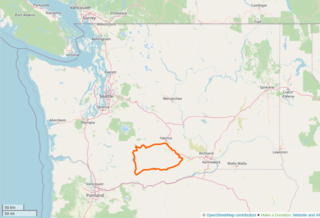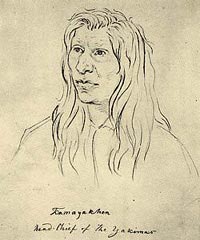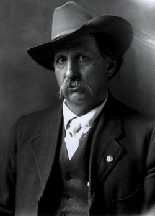Yakima, Washington is a city in the United States.
Yakima may also refer to:

The Yakima River is a tributary of the Columbia River in south central and eastern Washington state, named for the indigenous Yakama people. Lewis and Clark mention in their journals that the Chin-nâm pam called the river Tâpe têtt, possibly from the French tape-tête, meaning "head hit". The length of the river from headwaters to mouth is 214 miles (344 km), with an average drop of 9.85 feet per mile (1.866 m/km). It is the longest river entirely in Washington state.

Yakima is a city in, and the county seat of, Yakima County, Washington, United States, and the state's 11th-largest city by population. As of the 2020 census, the city had a total population of 96,968 and a metropolitan population of 256,728. The unincorporated suburban areas of West Valley and Terrace Heights are considered a part of greater Yakima.

Yakima County is a county in the U.S. state of Washington. As of the 2020 census, its population was 256,728. The county seat and largest city is Yakima. The county was formed out of Ferguson County in January 1865 and is named for the Yakama tribe of Native Americans.

Toppenish is a city in Yakima County, Washington. As of the 2020 census, the city population was 8,854. It is located within the Yakama Indian Reservation, established in 1855.

The Yakama are a Native American tribe with nearly 10,851 members, based primarily in eastern Washington state.

The Yakama Indian Reservation is a Native American reservation in Washington state of the federally recognized tribe known as the Confederated Tribes and Bands of the Yakama Nation. The tribe is made up of Klikitat, Palus, Wallawalla, Wanapam, Wenatchi, Wishram, and Yakama peoples.

The Yakima War (1855–1858), also referred to as the Plateau War or Yakima Indian War, was a conflict between the United States and the Yakama, a Sahaptian-speaking people of the Northwest Plateau, then part of Washington Territory, and the tribal allies of each. It primarily took place in the southern interior of present-day Washington. Isolated battles in western Washington and the northern Inland Empire are sometimes separately referred to as the Puget Sound War and the Coeur d'Alene War, respectively.

The Klickitat are a Native American tribe of the Pacific Northwest. Today most Klickitat are enrolled in the federally recognized Confederated Tribes and Bands of the Yakama Nation, some are also part of the Confederated Tribes of the Grand Ronde Community of Oregon.

Fort Simcoe was a United States Army fort erected in south-central Washington Territory to house troops sent to keep watch over local Indian tribes. The site and remaining buildings are preserved as Fort Simcoe Historical State Park, located eight miles (13 km) west of modern White Swan, Washington, in the foothills of the Cascade Mountains.
Sahaptin or Shahaptin, endonym Ichishkin, is one of the two-language Sahaptian branch of the Plateau Penutian family spoken in a section of the northwestern plateau along the Columbia River and its tributaries in southern Washington, northern Oregon, and southwestern Idaho, in the United States; the other language is Nez Perce or Niimi'ipuutímt.

Kamiakin (1800–1877) (Yakama) was a leader of the Yakama, Palouse, and Klickitat peoples east of the Cascade Mountains in what is now southeastern Washington state. In 1855, he was disturbed by threats of the Territorial Governor, Isaac Stevens, against the tribes of the Columbia Plateau. After being forced to sign a treaty of land cessions, Kamiakin organized alliances with 14 other tribes and leaders, and led the Yakima War of 1855–1858.
United States v. Winans, 198 U.S. 371 (1905), was a U.S. Supreme Court case that held that the Treaty with the Yakima of 1855, negotiated and signed at the Walla Walla Council of 1855, as well as treaties similar to it, protected the Indians' rights to fishing, hunting and other privileges.

Ahtanum Ridge is a long anticline mountain ridge in Yakima County in the U.S. state of Washington. It is located just south of the city of Yakima, and much of its length is at the northern edge of the Yakama Indian Reservation. Its name comes from the Sahaptin toponym [átanɨm].

Lucullus Virgil McWhorter was an American farmer and frontiersman who documented the historical Native American tribes in West Virginia and the modern-day Plateau Native Americans in Washington state. After living in West Virginia and Ohio, in 1903 he moved to the frontier of Yakima, Washington, in the eastern part of the state. He became a rancher and activist, learning much from his Yakama Nation neighbors and becoming an activist for them. In 1914 he was adopted as an honorary member of the Yakama, after helping over several years to defeat a federal bill that would have required them to give up much of their land in order to get any irrigation rights. They named him Hemene Ka-Wan,, meaning Old Wolf.
Glenwood is an unincorporated community and census-designated place (CDP) in Klickitat County, Washington, United States. It is 26.5 miles (42.6 km) west-northwest of Goldendale and has a post office with ZIP code 98619. The community is on land whose jurisdiction is disputed between the Yakama Nation and Klickitat County.
Washington v. Confederated Bands and Tribes of the Yakima Indian Nation, 439 U.S. 463 (1979), was a case in which the Supreme Court of the United States held that the State of Washington's imposition of partial jurisdiction over certain actions on an Indian reservation, when not requested by the tribe, was valid under Public Law 280.

Andrew Jackson Bolon was a Bureau of Indian Affairs agent whose 1855 death at the hands of renegade Yakama is considered one of several contributing factors in the outbreak of the Yakima War. Some sources assert Bolon was the first law enforcement officer killed in the line of duty in the territory that is now the state of Washington, though the Washington Peace Officers Memorial in Olympia, Washington lists a King County sheriff's deputy killed the year before Bolon's death.
Ahtanum Creek is a tributary of the Yakima River in the U.S. state of Washington. It starts at the confluence of the Middle and North Forks of Ahtanum Creek near Tampico, flows along the north base of Ahtanum Ridge, ends at the Yakima River near Union Gap and forms a portion of the northern boundary of the Yakama Indian Reservation. The name Ahtanum originates from the Sahaptin language, which was spoken by Native Americans in the region.
Patricia 'Patsy' L. Whitefoot is a member of Yakama Nation, is Indigenous elder, activist and professional educator along with being the traditional food gatherer for the Toppenish Creek Longhouse. She served as the President of the National Indian Education Association and President Obama appointed her as a member of the National Advisory Council on Indian Education. She is a prominent advocate for Missing and Murdered Indigenous Women, and Indigenous rights.

The Kittitas are a Sahaptin tribe closely related to the Yakama, sometimes described as a band or subtribe of the Yakama. Their traditional territories are found within Kittitas and Yakima counties within Washington state, chiefly in the Kittitas Valley, Naches Valley, Wenas Valley, and upper Yakima Valley. Individuals of Kittitas descent are today enrolled in the Confederated Tribes and Bands of the Yakima and the Confederated Tribes of the Colville Reservation, but the Kittitas are not recognized as a distinct band by either tribal government.